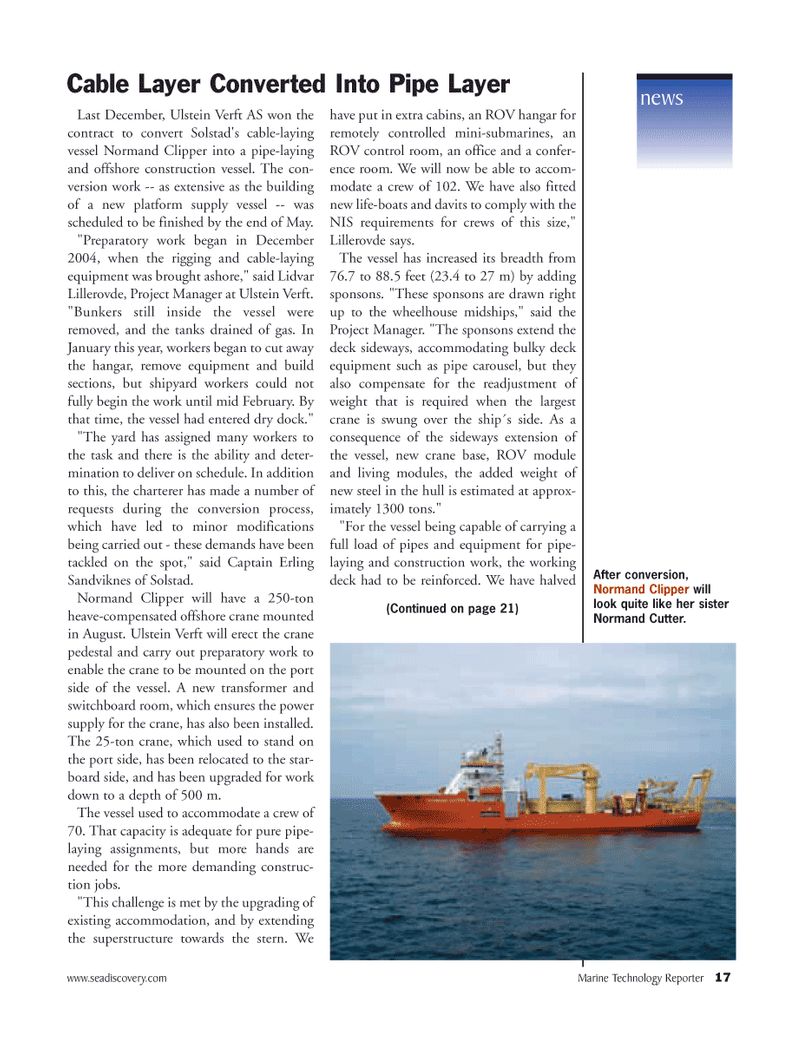
Page 17: of Marine Technology Magazine (September 2005)
Maritime Security & Undersea Defense
Read this page in Pdf, Flash or Html5 edition of September 2005 Marine Technology Magazine
Last December, Ulstein Verft AS won the contract to convert Solstad's cable-laying vessel Normand Clipper into a pipe-laying and offshore construction vessel. The con- version work -- as extensive as the building of a new platform supply vessel -- was scheduled to be finished by the end of May. "Preparatory work began in December 2004, when the rigging and cable-laying equipment was brought ashore," said Lidvar
Lillerovde, Project Manager at Ulstein Verft. "Bunkers still inside the vessel were removed, and the tanks drained of gas. In
January this year, workers began to cut away the hangar, remove equipment and build sections, but shipyard workers could not fully begin the work until mid February. By that time, the vessel had entered dry dock." "The yard has assigned many workers to the task and there is the ability and deter- mination to deliver on schedule. In addition to this, the charterer has made a number of requests during the conversion process, which have led to minor modifications being carried out - these demands have been tackled on the spot," said Captain Erling
Sandviknes of Solstad.
Normand Clipper will have a 250-ton heave-compensated offshore crane mounted in August. Ulstein Verft will erect the crane pedestal and carry out preparatory work to enable the crane to be mounted on the port side of the vessel. A new transformer and switchboard room, which ensures the power supply for the crane, has also been installed.
The 25-ton crane, which used to stand on the port side, has been relocated to the star- board side, and has been upgraded for work down to a depth of 500 m.
The vessel used to accommodate a crew of 70. That capacity is adequate for pure pipe- laying assignments, but more hands are needed for the more demanding construc- tion jobs. "This challenge is met by the upgrading of existing accommodation, and by extending the superstructure towards the stern. We have put in extra cabins, an ROV hangar for remotely controlled mini-submarines, an
ROV control room, an office and a confer- ence room. We will now be able to accom- modate a crew of 102. We have also fitted new life-boats and davits to comply with the
NIS requirements for crews of this size,"
Lillerovde says.
The vessel has increased its breadth from 76.7 to 88.5 feet (23.4 to 27 m) by adding sponsons. "These sponsons are drawn right up to the wheelhouse midships," said the
Project Manager. "The sponsons extend the deck sideways, accommodating bulky deck equipment such as pipe carousel, but they also compensate for the readjustment of weight that is required when the largest crane is swung over the ship´s side. As a consequence of the sideways extension of the vessel, new crane base, ROV module and living modules, the added weight of new steel in the hull is estimated at approx- imately 1300 tons." "For the vessel being capable of carrying a full load of pipes and equipment for pipe- laying and construction work, the working deck had to be reinforced. We have halved www.seadiscovery.com Marine Technology Reporter 17 news
Cable Layer Converted Into Pipe Layer
After conversion,
Normand Clipper will look quite like her sister
Normand Cutter. (Continued on page 21)
MTR#2 (17-32).qxd 8/30/2005 4:55 PM Page 17

 16
16

 18
18
